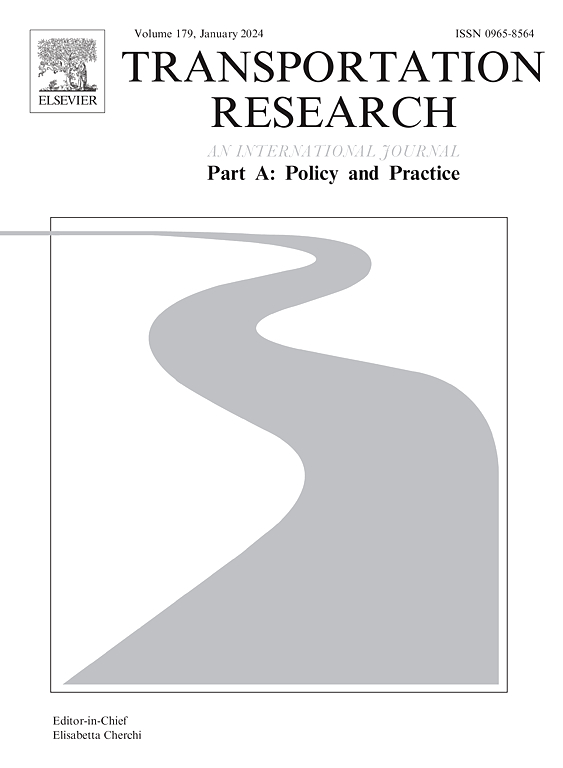定制目的地选择集的数据驱动新方法:荷兰案例研究
IF 6.3
1区 工程技术
Q1 ECONOMICS
Transportation Research Part A-Policy and Practice
Pub Date : 2024-10-04
DOI:10.1016/j.tra.2024.104278
引用次数: 0
摘要
旅行行为学界和政策制定者对目的地选择建模都非常感兴趣,他们希望通过建模了解总体和细分层面对土地利用和交通基础设施的需求,并制定政策来平衡需求和供给。地点选择预测面临的挑战之一是选择集太大。传统上,人们设计了许多方法来限制选择集的规模,这些方法有的是临时性的,有的是基于时空棱镜,通过删除被试者无法到达的地点来限制选择集的规模,而目前的研究则采取了一种截然不同的方法,提出了一种数据驱动的方法来定制选择集的生成。我们的主张是,通过观察市民连续多周的流动模式,我们可以根据受试者进行各种活动时的出行距离(超出或在其最常活动的出行距离之内)来限制选择集。更准确地说,利用纵向轨迹数据,我们首先根据人们在观察期间移动的区域(围绕他们最常去的 k 个地点:k-回旋半径)的大小,将他们分为两个亚组:回归者和探索者。然后为返回者(和探索者)定制四种活动的目的地选择集,并将其用于决策树所代表的一系列决策中,以预测他们的目的地。对整个样本和每个分组的模型分别进行了比较。结果表明,对所有四种选定的活动类型而言,目的地预测的准确性都有大幅提高,尤其是对回归者而言,他们的选择集是根据其回旋半径形成的。本文章由计算机程序翻译,如有差异,请以英文原文为准。
A novel data-driven approach for customizing destination choice set: A case study in the Netherlands
Modeling the destination choice has been of great interest for travel behavior community as well as policymakers in understanding the demand for land use and transportation infrastructures at aggregate and disaggregate levels and possibly devising policies to balance the demand and supplies. One of the challenges underlying predictions of location choice is the large choice set. While traditionally many methods had been devised to limit the choice set size either on a rather ad hoc basis or based on space–time prism by removing the locations out of reach of the subjects, the current study takes a substantially different approach and proposes a data-driven method to customize the generation of the choice set. The proposition is that observing the mobility patterns of citizens for multiple weeks would enable us to limit the choice set, depending on how far the subjects travel (beyond or within the distance they travel for their most frequent activities) to conduct their various activities. More precisely, using longitudinal trajectory data, we first classify people into two subgroups: returners and explorers, based on the size of the area (around their k most visited locations: k-radius of gyration) they move during the observation period. The destination choice set for four types of activities is then customized for returners (and explorers) and is used in a sequence of decisions represented by decision trees for the prediction of their destinations. The models for the whole sample and each subgroup separately are compared. The results suggest that the accuracy of destination prediction improves substantially for all four selected activity types, especially for the returners whose choice sets are formed based on their radius of gyration.
求助全文
通过发布文献求助,成功后即可免费获取论文全文。
去求助
来源期刊
CiteScore
13.20
自引率
7.80%
发文量
257
审稿时长
9.8 months
期刊介绍:
Transportation Research: Part A contains papers of general interest in all passenger and freight transportation modes: policy analysis, formulation and evaluation; planning; interaction with the political, socioeconomic and physical environment; design, management and evaluation of transportation systems. Topics are approached from any discipline or perspective: economics, engineering, sociology, psychology, etc. Case studies, survey and expository papers are included, as are articles which contribute to unification of the field, or to an understanding of the comparative aspects of different systems. Papers which assess the scope for technological innovation within a social or political framework are also published. The journal is international, and places equal emphasis on the problems of industrialized and non-industrialized regions.
Part A''s aims and scope are complementary to Transportation Research Part B: Methodological, Part C: Emerging Technologies and Part D: Transport and Environment. Part E: Logistics and Transportation Review. Part F: Traffic Psychology and Behaviour. The complete set forms the most cohesive and comprehensive reference of current research in transportation science.

 求助内容:
求助内容: 应助结果提醒方式:
应助结果提醒方式:


